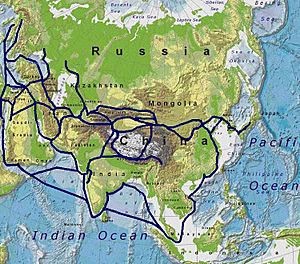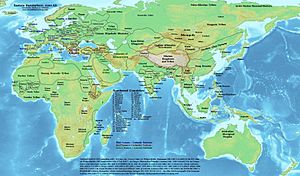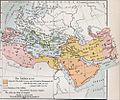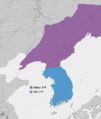History of Asia facts for kids



The history of Asia is a very long and exciting story. Asia is the largest continent on Earth. Its history can be seen as the story of different big regions. These include East Asia, South Asia, and the Middle East. How these regions connect often depends on what was happening in the central steppes.
Some of the world's first civilizations grew along Asia's coasts. These early societies developed around fertile river valleys. Great civilizations like those in Mesopotamia, the Indus Valley, and China shared many ideas. They likely traded technologies like mathematics and the wheel. However, things like writing often developed on their own in each place. Over time, these areas saw the rise of cities, then states, and finally large empires.
The central steppes were home to nomads. These groups could travel across much of Asia from their homeland. One of the earliest known groups to spread from the steppes were the Indo-Europeans. They brought their languages to the Middle East, India, and even near China. The far northern parts of Asia were hard for these nomads to reach. This was because of thick forests and cold tundra. These areas had very few people living in them.
Mountains and deserts often separated the central steppes from the coastal areas. The Caucasus, Himalaya, Karakum Desert, and Gobi Desert were huge barriers. Steppe horsemen found it very hard to cross them. People living in cities were more advanced in many ways. But they struggled to defend against the powerful horse armies from the steppes. When nomads conquered states in China, India, or the Middle East, they soon had to change. This was because the lowlands did not have enough open grasslands to support their large horse armies.
Ancient Asia
The ancient world saw many powerful empires rise in Asia. Alexander the Great was a famous Greek king. He conquered a huge area from Turkey to India in the 300s BC. Later, the Roman Empire also controlled parts of western Asia. Important empires like the Achaemenid, Seleucid, Parthian, and Sassanian empires were based in ancient Persia.
Many ancient civilizations were connected by the Silk Road. This famous trade route linked China, India, the Middle East, and Europe. It allowed goods, ideas, and cultures to spread. Two major religions, Hinduism and Buddhism, started in India. They had a big impact on South and East Asia.
Asia in the Middle Ages
The Islamic caliphate and other Islamic states began to grow in the Middle East in the 7th century. They later expanded into India and Indonesia. The Crusades were a series of wars starting in the 12th century. Christian Europeans tried to take back the Holy Land from Muslim control.
A huge change came in the 13th century with the Mongol Empire. This empire conquered a massive part of Asia. Their lands stretched all the way from China to Europe. It was one of the largest empires in history.
Modern Asia
The Russian Empire started expanding into Asia in the 17th century. By the end of the 19th century, Russia controlled all of Siberia and most of Central Asia. The Ottoman Empire ruled Turkey and the Middle East from the 16th century onwards. In the 17th century, the Manchu people conquered China. They started the Qing Dynasty. This dynasty declined in the 1800s and ended in 1912.
By the 1900s, several European countries controlled parts of Asia. Examples include British India, French Indochina, and Portuguese Macau and Goa. Russia and Britain competed for power in Central Asia during the 1800s. The Trans-Siberian Railway, which crosses Asia by train, was finished by 1916. Some parts of Asia stayed free from direct European control. These included Persia, Thailand, and most of China.
In the 1900s, Imperial Japan expanded its power. It took over parts of China, Korea, and Southeast Asia during the Second World War. After the war, many Asian countries gained independence from European powers. During the Cold War, northern Asia was mostly communist. This included the Soviet Union and the People's Republic of China. Western allies formed groups like CENTO and SEATO. Conflicts like the Korean War, Vietnam War, and Soviet invasion of Afghanistan were fought between communist and anti-communist sides.
After the Second World War, Japan rebuilt its economy. It became the world's second-largest economy. This was known as the Japanese post-war economic miracle. The Arab-Israeli conflict has been a major part of the Middle East's recent history. When the Soviet Union broke apart in 1991, many new independent nations formed in Central Asia.
Images for kids
-
The First Persian Empire at its greatest extent, c. 500 BC
-
The Silk Road in Asia
-
The early Muslim conquests, 622–750
-
The Turco-Mongol residual states and domains by the 15th century
-
The Delhi Sultanate.
-
Battle of Talas between Tang dynasty and Abbasid Caliphate c. 751
-
Korean peninsula in 476 AD. There are three kingdoms and Gaya Union in the picture. This picture shows the heyday of Goguryeo
-
Balhae in the north, Later Silla in the south
-
The Goryeo ware, which shows splendid culture of Goryeo in mediaeval Korea.
-
The first King of Goryeo, as known as Taejo of Goryeo (918–943)
-
Sculpture of Prince Shōtoku
-
The Hindu-Buddhist temple of Angkor Wat.
-
A view of the Fort St George in 18th-century Madras.
-
Gyeonghoeru of Gyeongbokgung, the Joseon dynasty's royal palace.
-
The Great Wave off Kanagawa, c. 1830 by Hokusai, an example of art flourishing in the Edo Period
-
The Mughal ambassador Khan’Alam in 1618 negotiating with Shah Abbas the Great of Iran.
-
Robert Clive and Mir Jafar after the Battle of Plassey, 1757 by Francis Hayman
-
Political cartoon depicting the Afghan Emir Sher Ali with the rival "friends" the Russian Bear and British Lion (1878)
-
Gojong (1852–1919), the 26th king of Joseon dynasty and the first emperor of Korean Empire.
-
Deoksugung, the palace where Emperor Gojong established Korean Empire.
-
The third Inter-Korean Summit, which was held in 2018, between South Korean president Moon Jae-in and North Korean supreme leader Kim Jong-un. It was a historical event that symbolized the peace of Asia.
See also
 In Spanish: Historia de Asia para niños
In Spanish: Historia de Asia para niños





























